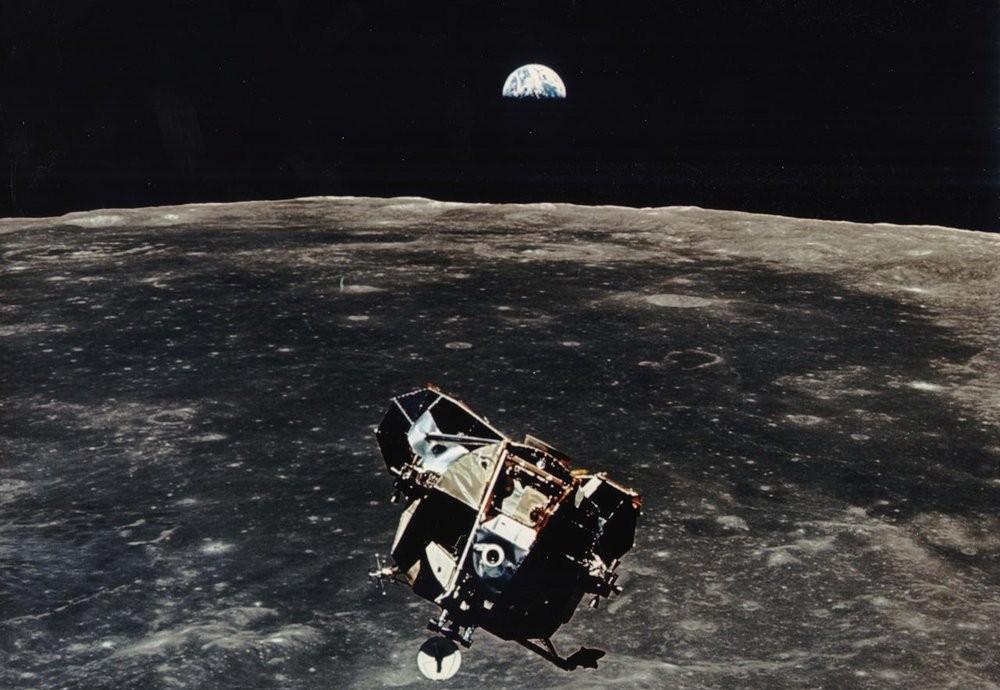Part of the Apollo 11 spacecraft that sent Armstrong to the moon may still be orbiting the moon.
An analysis by James Meador, an independent researcher at the California Institute of Technology, shows evidence that the spacecraft that helped astronauts ascend away from the moon and return to Earth may still be orbiting the moon 52 years after being dropped by NASA and thought to have crashed on the lunar surface, remaining in lunar orbit until today.
The three Apollo 11 astronauts Armstrong, Aldrin, and Collins were among the first to fly the lunar mission.

After the Apollo spacecraft arrived on the moon on July 20, 1969,
When the astronauts looked for a good landing site to land on the surface of the moon, there were only 30 seconds of fuel left on the spacecraft, and finally it was very thrilling to land the Apollo spacecraft in a flat area of the moon called the "Quiet Sea".
Aldrin was doing experiments on solar wind collection
Armstrong is known to have been the first human to set foot on the lunar surface, with fellow Edwin Aldrin as the second.
The third astronaut, Collins, waited for them in a command module circling over the moon... And watched as Armstrong and Aldrin stepped onto the lunar surface, bouncing joyfully on the moon.
(Close at hand but can not feel it personally, the sacrifice is not small, most people only remember the two that landed on the ground, and even thought that the two of them went to the moon).)
A 16 mm silent film camera mounted on the lander documented the historic event. Aldrin also gave the first oral description of the surroundings of the landing, including the type and size of the rocks, as well as the general color of the surface.
During the lunar surface activity, two astronauts raised the American flag and collected 20 samples of lunar rock weighing about 5.8 kilograms. In addition, they made it the first drink to be drunk on the surface of the moon.
Footage of the Eagle lander shortly after it left the command module
After completing a 21-hour lunar mission, leaving about a kilometer of footprints, the two astronauts lifted off from the lunar surface using an ascendant part called the Eagle Lander.
The two astronauts then successfully rendezvoused with Collins, who was circling the moon in the command module.
It should be noted that the Eagle Module Vehicle contains two space modules - the descending part and the ascending part. Needless to say, the former is still somewhere in the landing site of the Moon's Still Sea, but the ascendant module is not so certain. Before embarking on the journey home, the astronauts discarded the ascent capsule in the hope that it would crash on the lunar surface, and believed to eventually crash on the lunar surface.
However, researchers don't think so now. According to James Meador's simulations, the ascending module did not crash on the lunar surface, but continued to orbit the moon.
Aldrin followed Armstrong down the ladder
He mapped the trajectory of the spacecraft using a common mission analysis tool developed by NASA and the lunar gravitational field through the GRAIL project launched in 2012.
Combining data from GRAIL and the Common Mission Analysis Tool, the researchers conducted a series of simulations that adjusted for other parameters and conditions that might exist when the ascending segment was discarded. Includes solar radiation, gravitational fields, and other anomalous parameters. The results showed that all the simulations pointed to the fact that the abandoned module was still in a stable orbit around the Moon.
In addition to the abandoned ascendion segment, the Apollo 11 astronauts deliberately left behind a number of other commemorative items.
These include a silicon disc inscribed with the friendly greetings of 73 world leaders and an item on Apollo 1 commemorating the three American astronauts killed in the 1967 fire, Virgil I. Grissom, Edward H. White and Roger B. Chaffee. There are also two Soviet medals commemorating the Death of Soviet astronaut Vladimir Vladimir Vladimir V. Khrushchev, who was killed in the Soyuz 1 accident. Vladimir M. Komarov and Yuri A. Gagarin, the first astronauts killed in a plane crash in 1968. And a small golden olive leaf, which corresponds to several other copies of the exact same, so that the astronauts can take it to the moon and bring it back to Earth as a souvenir for their wives.
But so far, even as countries around the world are busy landing on the moon and planning to build permanent lunar bases, NASA has yet to issue any statement on whether the ascended module is still in orbit.
Generally speaking, NASA will not track its spacecraft once the mission is over, because the personnel involved believe that the aircraft will either explode or exceed the range of human contact, that is, escape to the deep space of the universe. However, according to Midor's calculations, the eagle module of the ascending segment, which can be detected at the exact location, can start a salvage journey to space in the future, bring the Eagle module back to Earth, and put it in the museum to commemorate the most important "step" in human history.
The new U.S. lunar spacecraft, Orion, has been assembled
Now that NASA's Artemis mission to the moon is in full swing, it is unclear whether salvaging the craft is a goal. However, the new manned Orion spacecraft used in the Artemis mission has made huge upgrades and improvements on the Apollo spacecraft, and is also very spacious, and will be launched to the moon early next year for test flights.
We, China and Russia, have also signed an agreement to build the first lunar research station, and a manned lunar landing has long been a set goal.
At that time, maybe we can help verify the results of this study.